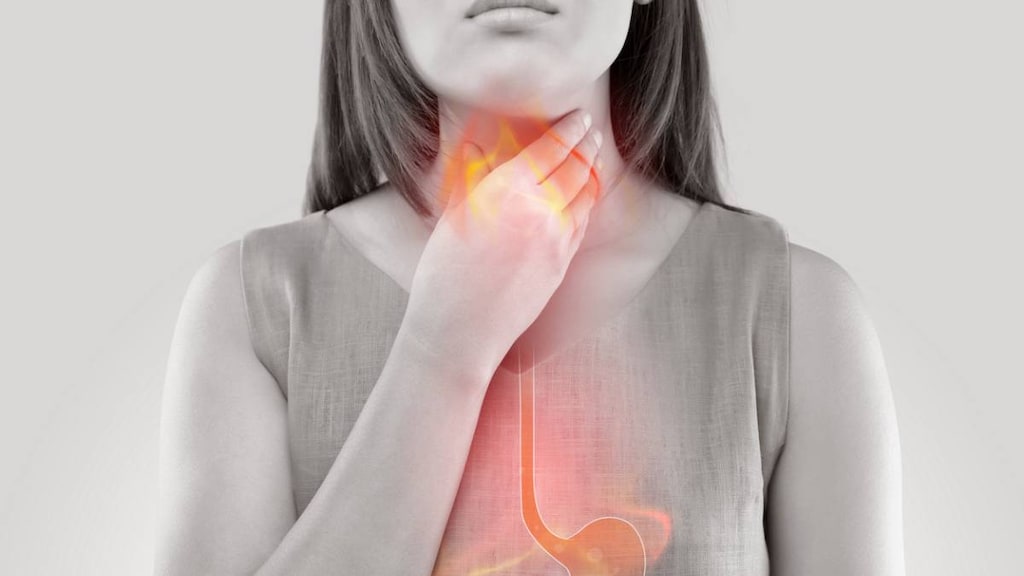Common stomach acid problems and the medications used to treat them

Stomach acid is a key component of the gastric juice we produce every day, but problems can occur if:
- You have too much stomach acid
- The protective barrier in your stomach breaks down
- The ring of muscles (sphincter) at the top of your stomach doesn't work properly and lets stomach acid rise into the esophagus
Gastric juice is made up of stomach or gastric acid (hydrochloric acid, HCl), digestive enzymes (pepsin), mucus and bicarbonate.
Stomach acid is highly acidic with a pH of about 1 to 3. It works along with enzymes to help break down the foods you eat and also to kill bacteria. The mucus and bicarbonate helps to protect your stomach from the acidic gastric juice.
Common stomach acid-related health conditions
Stomach acid-related problems are associated with a number of different health conditions. Here are four conditions commonly associated with stomach acid issues.
- Peptic ulcers. Peptic ulcers are small holes that appear when the lining of the stomach or gut breaks down. Stomach or gastric ulcers are a type of peptic ulcer found in the lining of the stomach. Duodenal ulcers are another type of peptic ulcer found near the stomach, in the upper part of the small intestine or gut. Peptic ulcers are commonly caused by infection with Helicobacter pylori or long-term use of nonsteroidal anti-inflammatory drugs (NSAIDs).
- Gastroesophageal reflux disease (GERD). GERD is a condition where gastric juices flow back up into the esophagus, causing chronic inflammation and tissue damage. It commonly occurs when the lower esophageal sphincter - a ring of muscles between the stomach and the esophagus - relaxes inappropriately.
- Indigestion (dyspepsia). Indigestion describes a range of symptoms, including stomach pain, heartburn, bloating, nausea, vomiting and burping, which are associated with irritation of the stomach lining. In some cases there is no obvious cause for indigestion, but in other cases it is linked to peptic ulcers or GERD.
- Gastritis. Gastritis is a term used to describe conditions that cause inflammation of the stomach lining. It can be caused by a range of different factors including alcohol, chronic NSAID use, reduced blood flow to the stomach, increased acid production, an autoimmune response or an infection with H. pylori.
Signs that you may have stomach acid-related problems
Here are some signs and symptoms caused by stomach acid problems:
- Stomach or chest pain
- Heartburn or a burning feeling that rises up from your stomach to your neck
- Gnawing discomfort
- Sour taste in mouth accompanied by regurgitation of food
- Bad breath
- Hoarse voice or throat clearing
- Chronic cough
- Bloating
- Nausea or vomiting
- Diarrhea
- Decreased appetite
- Difficulty swallowing
Medications to help treat stomach acid problems
There are a number of different types of medications available to help treat stomach acid problems. Some of these are available over-the-counter (OTC), while others require a prescription.
Stomach acid medications may need to be taken continuously, or used intermittently for short periods of time, or taken on-demand as symptoms occur. Check with your healthcare professional about which option is best for you.
Stomach acid medications are most commonly taken by mouth in the form of a tablet, capsule or liquid, but some may also be given by IV (intravenously)
The different types of medications work in different ways to help combat stomach acid problems. Some reduce the amount of acid you produce, some neutralize the acid and others simply help to protect your insides.
Here’s a list of different types of medications used to help treat, heal and protect against stomach acid problems:
Proton pump inhibitors
Proton pump inhibitors (PPIs) work by reducing the amount of acid that your stomach produces. They do this by blocking the action of an enzyme called H+/K+ ATPase, which is also known as a proton pump. The H+/K+ ATPase enzyme is found in the parietal cells in the stomach and is involved in the final step of stomach acid production.
PPIs are usually the treatment of choice for stomach acid problems including peptic ulcers and GERD. They provide relief from heartburn and regurgitation, and are better at promoting healing than H2 blockers.
PPIs are available OTC and on prescription. Examples of PPIs include:
- Prilosec (omeprazole)
- Zegerid (omeprazole and sodium bicarbonate)
- Nexium (esomeprazole)
- Prevacid (lansoprazole)
- Dexilant (dexlansoprazole)
- Protonix (pantoprazole)
- Aciphex (rabeprazole)
Some people will need to take a PPI long-term and in this situation the lowest effective dose should be used. Other people may be able to use a PPI intermittently or on-demand.
Histamine-2 blockers
H2 blockers, which are also known as histamine-2-receptor antagonists (H2RAs), work by reducing the amount of acid produced by your stomach. Histamine is released by the enterochromaffin-like cells (ELC) in your stomach, which stimulates the acid-producing parietal cells to release stomach acid. H2 blockers bind to parietal cells, preventing them from binding and responding to histamine and releasing stomach acid.
H2 blockers are available OTC and on prescription. Examples of H2 blockers include:
- Pepcid AC (famotidine) and Pepcid Complete (famotidine with calcium carbonate and magnesium hydroxide)
- Tagamet HB (cimetidine)
- Axid AR (nizatidine)
H2 blockers are commonly used when OTC antacid drugs are not strong enough. They are recommended for short-term or on-demand use for people with GERD, peptic ulcers, gastric hypersecretion and mild or infrequent heartburn and indigestion.
Antacids
Antacids are a group of drugs that have been around for many years and work by neutralizing stomach acid.
Many antacids contain salts of magnesium and aluminum and some also contain salts of calcium. Sodium bicarbonate may also be found in some antacids. Exactly how each antacid neutralizes stomach acid depends on the specific ingredients it includes.
In addition to neutralizing stomach acid, antacids may also work in other ways to help heal ulcers, such as by suppressing the growth of H. pylori, promoting the growth of new blood vessels and more. Antacids help to relieve the symptoms of mild heartburn and indigestion.
Antacids are available OTC. Examples of antacids include:
- Mylanta (Aluminum and magnesium hydroxide)
- Rolaids (Calcium carbonate and magnesium hydroxide)
- Tums (Calcium carbonate)
They are now generally used on-demand to treat mild or intermittent heartburn associated with conditions like GERD, but antacids were once used more broadly before PPIs were developed.
Alginates
Alginates are available OTC and are used to help relieve the symptoms of mild-to-moderate reflux. Alginates are naturally occurring sugars found in brown algae (seaweed). Alginate forms a foamy gel when it comes into contact with stomach acid which creates a ‘raft’ over the stomach’s contents, preventing it from traveling back up into the esophagus. They help to relieve reflux and heartburn symptoms.
Alginates can be used alone, or combined with other medications such as antacids or PPIs.
Gaviscon Extra Strength liquid is an example of a medication that contains both an antacid and an alginate. It is used to treat heartburn.
Sucralfate
Sucralfate is a mucosal protective agent that is largely unabsorbed by the body and may be recommended for pregnant people with GERD. Sucralfate is used to treat and prevent ulcers and works by sticking to the damaged area.
Sucralfate may be used alongside antacids and alginates.
Sucralfate is available on prescription, including under the brand name Carafate.
Antibiotics
Some peptic ulcers are caused by chronic infection with H. pylori, which is a common bacterial infection worldwide. H. pylori causes chronic inflammation. It also plays a role in the development of gastric cancer.
Antibiotics are used in combination with a PPI to eradicate H. pylori infection in people who test positive for it. There are a number of different drug combinations used to treat H. Pylori infection including:
- Triple therapy - with a PPI, clarithromycin and amoxicillin or metronidazole for 14 days
- Quadruple therapy - with a PPI, bismuth, tetracycline and a nitroimidazole for 10-14 days
- Talicia three-drug combination therapy - with the PPI omeprazole, amoxicillin and rifabutin
Bottom line
There are a number of different types of drug therapy available for the treatment of stomach-acid related conditions. Check with your healthcare professional about which option is best for you.
Article references
- Hsu M, Safadi AO, Lui F. Physiology, Stomach. [Updated 2021 Jul 22]. In: StatPearls [Internet]. Treasure Island (FL): StatPearls Publishing; 2022 Jan-. Available at: https://www.ncbi.nlm.nih.gov/books/NBK535425/. [Accessed April 4, 2022].
- Katz PO, Dunbar KB, Schnoll-Sussman FH, Greer KB, Yadlapati R, Spechler SJ. ACG Clinical Guideline for the Diagnosis and Management of Gastroesophageal Reflux Disease. Am J Gastroenterol. 2022;117(1):27-56. doi:10.14309/ajg.0000000000001538.
- Moayyedi P, Lacy BE, Andrews CN, Enns RA, Howden CW, Vakil N. ACG and CAG Clinical Guideline: Management of Dyspepsia [published correction appears in Am J Gastroenterol. 2017 Sep;112(9):1484]. Am J Gastroenterol. 2017;112(7):988-1013. doi:10.1038/ajg.2017.154.
- Ahmed A, Clarke JO. Proton Pump Inhibitors (PPI) [Updated 2021 Aug 1]. In: StatPearls [Internet]. Treasure Island (FL): StatPearls Publishing; 2022 Jan-. Available at: https://www.ncbi.nlm.nih.gov/books/NBK557385/. [Accessed April 4, 2022].
- Nugent CC, Falkson SR, Terrell JM. H2 Blockers. [Updated 2022 Feb 13]. In: StatPearls [Internet]. Treasure Island (FL): StatPearls Publishing; 2022 Jan-. Available at: https://www.ncbi.nlm.nih.gov/books/NBK525994/. [Accessed April 4, 2022].
- Salisbury BH, Terrell JM. Antacids. [Updated 2021 Aug 21]. In: StatPearls [Internet]. Treasure Island (FL): StatPearls Publishing; 2022 Jan-. Available at: https://www.ncbi.nlm.nih.gov/books/NBK526049/. [Accessed April 4, 2022].
- Bor S, Kalkan İH, Çelebi A, et al. Alginates: From the ocean to gastroesophageal reflux disease treatment. Turk J Gastroenterol. 2019;30(Suppl2):109-136. doi:10.5152/tjg.2019.19677.
- MedlinePlus. Sucralfate. April 15, 2017. Available at: https://medlineplus.gov/druginfo/meds/a681049.html. [Accessed April 4, 2022].
- Food and Drug Administration (FDA). Carafate. Available at: https://www.accessdata.fda.gov/drugsatfda_docs/label/2013/018333s034,019183s016lbl.pdf. [Accessed April 4, 2022].
- Chey WD, Leontiadis GI, Howden CW, Moss SF. ACG Clinical Guideline: Treatment of Helicobacter pylori Infection [published correction appears in Am J Gastroenterol. 2018 Jul;113(7):1102]. Am J Gastroenterol. 2017;112(2):212-239. doi:10.1038/ajg.2016.563.
- Food and Drug Administration (FDA). Other-The-Counter (OTC) Heartburn Treatment. March 12, 2021. Available at: https://www.fda.gov/drugs/information-consumers-and-patients-drugs/over-counter-otc-heartburn-treatment. [Accessed April 4, 2022].
- Gisbert JP. Rifabutin for the Treatment of Helicobacter Pylori Infection: A Review. Pathogens. 2020;10(1):15. Published 2020 Dec 28. doi:10.3390/pathogens10010015.
- Food and Drug Administration (FDA). Talicia. Available at: https://www.accessdata.fda.gov/drugsatfda_docs/label/2022/213004s007lbl.pdf. [Accessed April 4, 2022].


